The failures of the first days of the Ukrainian offensive on the southern lines of the front apparently led to a change in the tactics of the Ukrainian command. Kiev realised that its forces had failed to achieve any decisive success in one sector of the front in a short period of time.
This does not mean that the Ukrainian administration and the West abandoned the idea of recapturing the lost territories in the summer of 2023, but they were forced to revise the timing of planned offensive operations.
This is why the Kahovka hydroelectric dam was hit; in order to destroy the minefields and the Russian army's forward positions in this sector of the front. The water will certainly be gone by mid-summer. Apparently, Kiev believes that it will not give the Russians time to re-strengthen their positions on the eastern bank of the Dnieper River.
Another reason for the destruction of the Kakhovka dam was to start another wave of anti-Russian hysteria in the Western media, which will allow Zelensky's office to ask for more military supplies and financial aid.
In the coming days, the Armed Forces of Ukraine are expected to escalate fighting in the Zaporizhzhya region, as well as launch new large-scale raids deep into Russian territory in the Belgorod region. The success of these actions will depend not so much on the available forces and assets of the Armed Forces of Ukraine, but on the effectiveness of the Russian military's response to these provocations.
Judging by the poor results of the latest Ukrainian attacks in both the Belgorod and Zaporizhzhya regions, the Russian command has learned lessons from its previous mistakes. Over the past four days, Kiev has suffered significant losses in manpower and military equipment. According to the Russian Defence Ministry, the Ukrainian army has lost more than 4,000 soldiers dead and wounded and dozens of pieces of military equipment, including NATO tanks.
The Russians maintain air superiority on the front lines and Moscow has managed to achieve some parity in the use of strike and reconnaissance UAVs in combat.
Russian aerospace forces continue high-precision strikes both at the operational rear of the Ukrainian troop grouping and in the strategic depth of Ukrainian territory, destroying key military infrastructure facilities. On 6 June, a successful strike on another Ukrainian command centre was announced.
Kiev's current strategy is based on the hope that Russia will exhaust its military potential faster than NATO's collective military machine. This idea only seems reasonable if NATO decides to go directly to war with Russia. Now NATO's arms flow is just foolishly burning on the fronts to no effect.



